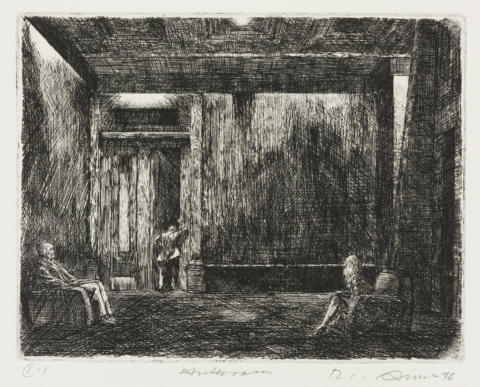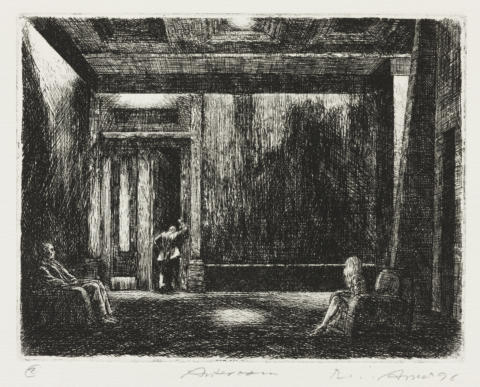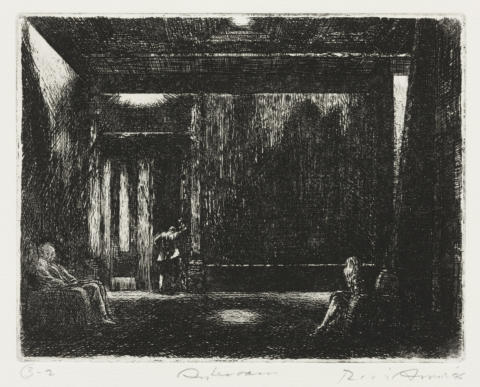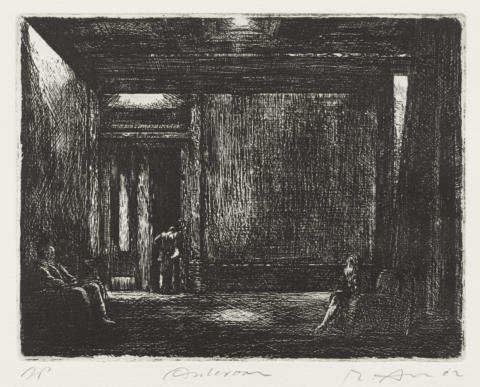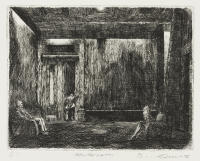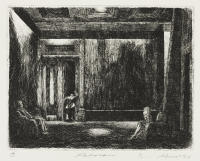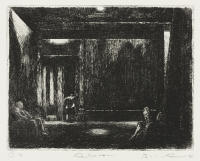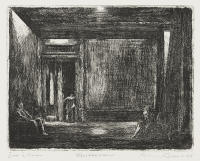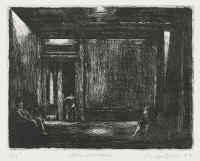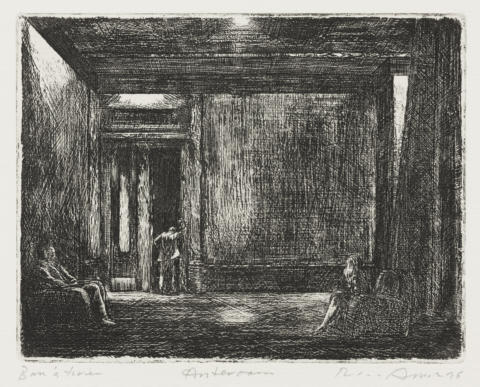
Etching. In a large anteroom with a high, coffered ceiling a man and a woman sit in armchairs, opposite one another. The woman, who is seated at the right, looks towards the back of the room, where a besuited man, his back to the viewer, stands leaning against a doorway, his right arm raised to support him. There are three variant impressions of this state.
Many areas of the plate have been darkened with the addition of etched hatching and cross-hatching; these areas include the back wall, the wall at left, the back of the woman’s armchair, the side of the man’s armchair, and the figure of the standing man. Conversely, areas of light have been extended; these include the light area on the upper part of the wall at left, the circular light in the ceiling, the long inverted triangle of light at the right, and the pools of light on the floor. The architectural details around the standing man have been clarified with more etching. The features of the seated man’s face have been more clearly defined and his trousers have been modelled with shading.
The plate has been comprehensively re-etched, with the dark areas further darkened; the image now shows large areas of dense black tone. Hatching has been added to the seated man’s face, obscuring its detail. There are two variant impressions of this state.
Much of the plate has been burnished, to create a more tonally differentiated scene. The burnished areas include the back and left walls and the floor.
The light area on the floor has again been burnished, and now appears fractionally lighter. According to Amor’s intaglio record books, this state dates from May 2002.
- Catalogue Number
- E.102
- Title and Date
- Anteroom
1996; reworked 1999 and 2002
- Description of Featured Image
- In a large anteroom with a high, coffered ceiling a man and a woman sit in armchairs, opposite one another. The woman, who is seated at the right, looks towards the back of the room, where a besuited man, his back to the viewer, stands leaning against a doorway, his right arm raised to support him.
- Where Made
- Alphington, Melbourne
- Medium Category and Technique
- Intaglio Print: Etching and burnishing on copper
- Support
- Wove paper. Identified papers: Magnani Acqueforti 300 gsm paper; Velin Arches 250 gsm paper with watermark: ‘ARCHES / france’ with infinity symbol.
- Dimensions
-
Image size: 159 x 205 mm
Matrix size: 159 x 205 mm - Artist’s Record Number
- RAE.108 (1996), RAE.148 (2002)
- Printer(s) and Workshop(s)
- States I through IV, and first edition, printed by Rick Amor in his Alphington studio. State V, and second edition, printed by Martin King at the Australian Print Workshop, Fitzroy (Melbourne). State VI printed by Amor in the Alphington studio. Third edition printed by Martin King at the APW.
- Summary Edition Information
- Six states. Three editions. First edition: nominal edition of ten, but only five impressions printed and numbered, 1996. Second edition: edition of ten numbered impressions, 1999. Third edition: edition of ten numbered impressions, 2002.
- Exhibitions
- Niagara Galleries at IWOP 1997: Niagara Galleries at the International Works on Paper Fair, Mitchell Galleries, State Library of New South Wales, Sydney, 17–20 July 1997, no. 13 (1996).
- Literature
- For an illustration of the painting Study for ‘The ante-room’, 1993, see Niagara Galleries, Rick Amor (exh. cat.), Niagara Galleries, Richmond, Victoria, 1994, cat. no. 6.
- Chris Wallace-Crabbe, ‘Painting in a Dangerous Area’, Art Monthly (Australia), November 1995, pp. 10–11.
- Collections
- State Library of Victoria, Melbourne: six state impressions, numbered 1-1, 3-1, 1-2, 2, 3-2, 1-3, all dated 1996; bon à tirer impression, dated 1996; AP II, dated 1996; ed. 5/10, dated 1996; AP, dated 2002; ed. 2/10, dated 2002.
- Comment
The subject of E.102 is based on that of an earlier etching of the same title, Ante-room, 1993 (cat. no. E.076), but the orientation of the composition has been reversed. The original model for both etchings is the painting Study for ‘The ante-room’, 1993 (Niagara Galleries 1994). The etchings and the painting, and other related works, form a group of closely related compositions, whose interiors combine architectural elements drawn from a number of places. The setting here, as in E.076, was inspired by the upstairs foyer of the Astor Theatre, an Art Deco cinema (built 1935–36) in the inner Melbourne suburb of St Kilda.
Apart from the larger dimensions of the plate, the major change in the present etching by comparison with E.076 was the repositioning of the seated figures. By bringing them closer to the foreground, and thus increasing the distance between them and the standing man at the back, Amor enlarged the internal scale of the composition, which became more cavernous. The effect was a subtle shift in the print’s enigmatic narrative.
The literary inspiration for Amor’s subject was T. S. Eliot’s poem ‘Sweeney among the Nightingales’ (1918). Amor appreciates what he has referred to as Eliot’s ‘dry and flat speaking voice’, which he had heard on a set of cassette tapes he owned of the poet reading. Eliot’s vocal character, Amor thought, corresponded to the visual character of his own images. In E.102 and E.076, the artist has responded to the tensely allusive narrative of the Sweeney poem, with its references to silent men and muffled conversations. Amor has also linked the uneasy narrative of his anteroom subject to the moody, surreal cinematic narratives of David Lynch, whose films he admires.
The adjustments made to E.102 through the progression of its states involved some changes to compositional details, but were chiefly tonal. The intensification of the dark areas in the second state served also to highlight the areas of light, thus increasing the sense of drama in the image. With the re-etching of the plate in the third state, the subject was plunged into a deeper darkness, which shrouds the seated man at left, and thus tilts the dramatic focus towards the standing man and the seated woman. The later states are burnished back to the grey tones of half light, which evoke an atmosphere of disquiet.
- Keywords
- Building interior, Interior
- URL
- https://catalogue.rickamor.com.au/works/intaglio/ante-room/
Record last updated 16/02/2021
